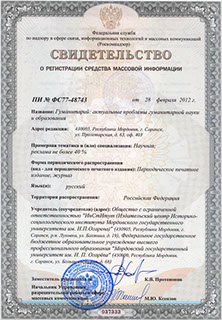ГуманитариЙ актуальные проблемы гуманитарной науки и образования
Russian Journal of the Humanities
ISSN 2078-9823 (Print)
ISSN 2587-7879 (Online)
Navigation
D. K. Romanov
National Research Mordovia State University, Saransk, Russia, e-mail: famylypost@mail.ru
METHODS OF REPRESENTATION OF INTERPERSONAL UNDERSTANDING OF THE SUBJECT IN SPEECH DESCRIPTIONS OF A CLOSED PERSON
In the article the author discusses the problem of interpersonal understandig. An object of analysis is the image of other person. With the help of a technique of the free characteristic of other person it is proved that the image is a product of cognitive activity of the subject of knowledge. As indicators of cognitive activity of the subject colocations in which it’s presented are considered: directly and indirectly. Depending on level and a way of representation of the subject of colocations have been distributed on a conditional scale. On one side of this scale there were colocations in which the subject of interpersonal understanding is presented in the maximum degree, and in a direct and open form, i. e. explicitly, for example, «I help mother to set the table», «If I receive an excellent mark, mother praises me». On other side there are colocations in which the subject isn’t mentioned at all. It’s presented there in an implicit form and at extremely minimum level, for example, «She is kind», «She works as a seller». Only the special analysis allows to find its presence. All other types of colocations were distributed between these sides. Along with it the hypothesis has been made that the allocated types of colocations have the different genetic status. Colocations with open subjectivity are the earliest by origin. The colocations with extremely implicit subjectivity presented by psychological concepts are the latest by origin and, at the same time, the most developed and perfect means of interpersonal understanding. Seven ways of representation of the subject are allocated. Behind each of them there are different cognitive systems. They differ from each other in the generality level, pragmatical opportunities, nature of connection with personal experience of the subject, the genetic status and other features. The image of other person includes all cognitive systems that does it by the effective instrument of communication.
Keywords: interpersonal understanding, communication, activity, subject, content-analysis, semantic colocation, subjective judgment, methods of representation, generalization, subject-centrizm.

© Ogarev Mordovia State University. History and Sociology Institute, 2017
68, Of. 411, Bolshevistskaya St., 430005, The editorial office of the scholarly journal «Russian Journal of the Humanities»
Tel.: (8342) 24-25-90; 27-07-11, Fax: (8342) 24-25-90, E-mail: jurnal-econom-hist@isi.mrsu.ru
Designed by A. Napalkov, Email: napalkov@isi.mrsu.ru

